Scottish Crime and Justice Survey 2019/20: main findings
Main findings from the Scottish Crime and Justice Survey 2019/2020, including self-completion findings covering the period 2018/19 to 2019/20.
This document is part of a collection
7. Public perceptions of crime and safety
In addition to measuring the extent and prevalence of crime, the Scottish Crime and Justice Survey (SCJS) also enables us to understand public perceptions of crime and safety and how these have changed over time. It is important to note that a variety of factors will influence perceptions of crime in local communities and the country as a whole, so opinions or concerns may not reflect wider trends in victimisation. Moreover, what respondents consider when asked about crime may go beyond the categories of victimisation captured by the SCJS.
How did the public think the level of crime in their local area had changed in recent years?
In 2019/20, just under three-quarters of adults thought the local crime rate had been stable or fallen in the previous two years, an improvement since 2008/09 and unchanged since 2018/19.
One of the indicators in the Scottish Government's National Performance Framework is the public's perception of the crime rate in their local area. The SCJS is used to evidence this indicator which tracks the proportion of adults who believe that the crime rate has stayed the same or reduced[85] in the past two years in their local area.[86]
73% of adults in 2019/20 said that the crime rate in their local area had decreased or stayed the same over the last couple of years. This figure has improved from 69% in 2008/09 and is unchanged from 2018/19, as shown in Figure 7.1.
Looking more closely at trends over time reveals that the growth in the 'stayed the same or reduced' combined measure over the last decade has been driven by more people believing the crime rate in their local area has 'stayed the same' which has consistently accounted for most of this group, improving from 60% of adults in 2008/09 to 65% in 2019/20. On the other hand, in the latest survey just under one-in-ten (8%) thought the crime rate had decreased, lower than the position in 2008/09 (9%).
Taken together, these findings mean that fewer people thought the amount of crime in their local area had increased in the two years prior to interview in 2019/20 (23%) than in 2008/09 (28%), again unchanged from 2018/19.
However, whilst the longer term picture is positive, comparing the latest results to the position in 2016/17 reveals a rise in people thinking crime has increased (from 19% to 23%), with fewer believing crime has fallen in the two years prior to interview. Therefore, this data will be important to monitor in the coming years.
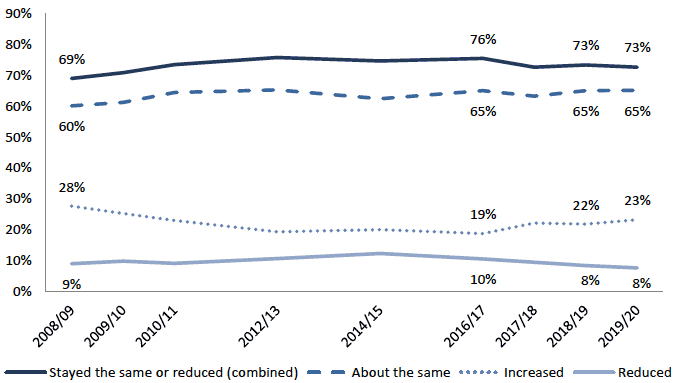
Base: All adults who have lived in local area for two years or more - SCJS 2008/09 (14,210); 2009/10 (14,380); 2010/11 (11,700); 2012/13 (10,640); 2014/15 (10,050); 2016/17 (4,830); 2017/18 (4,770); 2018/19 (4,820); 2019/20 (4,920); Variable: QS2AREA
A smaller proportion of females, victims of crime, those in deprived areas and those in urban areas believed the local crime rate had been stable or fallen compared to comparator groups.
In 2019/20, most adults (typically around 70% or greater) in each population group thought the volume of local crime had stayed the same or reduced in the previous two years. However, the proportion in each group holding this view did vary - for instance:
- fewer women than men (69% compared to 76%)
- fewer victims of crime than non-victims (59% compared to 74%)
Further breakdowns and time-series analyses are provided in Annex table A1.11. It reveals improvements in perceptions since 2008/09 across a number of population breakdowns, although the latest survey results were unchanged from the baseline position for people aged 25 to 44 years old, victims of crime, those in the most deprived areas, and those in rural locations.
More recently, figures showed no change across most population groups between 2018/19 and 2019/20.
Scottish Surveys Core Questions
Whilst the SCJS is the preferred source for national results on perceptions of the local crime rate, this question is currently part of the Scottish Surveys Core Questions (SSCQ) which sees a selection of measures collected in the same way across the three large household surveys in Scotland - the Scottish Health Survey (SHeS), the Scottish Household Survey (SHS), and the SCJS. Results from the three surveys on the core questions are pooled together each year to offer a larger sample size, enabling more precise and granular breakdowns of results for equality groups and at local level. More on the SSCQ, including the latest results available on the local crime rate indicator from the three surveys combined, can be found on the SSCQ website.
How did views on local and national crime trends differ in 2019/20?
As in previous years, adults were more likely to think crime had risen across the country as a whole than in their local area in the two years prior to interview.
Whilst the previous section looked at views on crime rates in respondents' local areas, the SCJS also collects data on perceptions of national crime trends.
In 2019/20, almost half of adults in Scotland (45%) believed that crime had increased across the country as a whole in the two years prior to interview, whilst the SCJS estimates that the overall level of crime in Scotland has shown no change since 2017/18.
The proportion of adults who thought crime had increased in the latest survey was smaller than the 52% who felt this way in 2009/10.[87] However, this proportion has increased from a low of 34% in 2014/15 and 41% in 2017/18, but has remained unchanged from 2018/19 (Table 7.1).
| Percentage of adults holding view on change in national crime rate: | 2019/20 | Change since 2009/10 | Change since 2018/19 |
|---|---|---|---|
| A lot more / a little more | 45% | ↓ from 52% | No change |
| About the same | 39% | ↑ from 36% | ↑ from 36% |
| A lot less / a little less | 6% | ↑ from 4% | No change |
| Don't know / Refused | 9% | No change | No change |
| Combined: Less or same | 45% | ↑ from 40% | No change |
| Number of respondents | 5,570 | 16,040 | 5,540 |
Variable: QS2AREAS.
Comparing local and national perceptions, the proportion of adults in 2019/20 believing crime had increased in Scotland overall (45%) was much greater than the 23% who thought the level of crime in their local area had grown in recent years.[88] In other words, people were much less likely to say crime had been stable or fallen nationally (45%) than in their local area (73%). This variation in perceptions across geographic levels has been identified consistently by the SCJS over the years and by other surveys across the UK - most notably the Crime Survey for England and Wales (CSEW) and the Northern Ireland Safe Community Survey (NISCS).
Looking more closely, Figure 7.2 highlights that the difference in those believing crime has increased is mostly accounted for by people being much less likely to think the crime rate has been stable in Scotland overall.
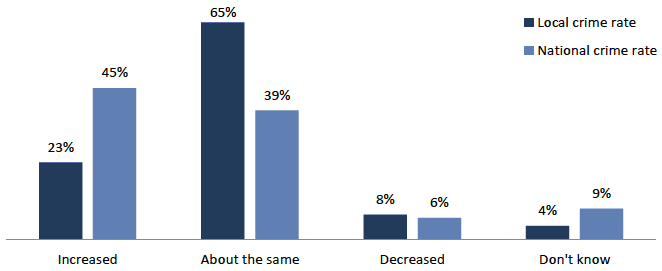
Base: Local crime rate: All adults who have lived in local area for two years or more (4,920); National crime rate: All adults (5,570); Variables: QS2AREA; QS2AREAS.
Views on the national crime rate also varied by demographic characteristics. For example, women were less likely to think crime had been stable or fallen across the country as a whole than men (39% compared to 52%, respectively). This finding is similar to the pattern in views on the local crime rate.
The perception of the national crime rate also varied with age, with older people less likely to believe it had been stable or fallen in the last two years (for example 35% of those aged 60 and over compared to 59% of those aged 16 to 24).
In contrast to perceptions of the local crime rate, the 2019/20 SCJS detected no difference in views on the trend in the national crime rate between victims of crime and non-victims, and those living in the most deprived areas of Scotland compared to the rest of Scotland.
Those in urban areas were more likely than those in rural areas to believe the national crime rate had been stable or fallen in the last two years (46% compared to 40%, respectively), despite being less likely to think the local crime rate had been stable or fallen in the last two years (72% compared to 76%, respectively).
Further breakdowns and trends within groups over time are provided in Annex table A1.12.
How safe did the public feel in 2019/20?
More adults felt safe when walking alone in their local area or on their own at home during the night in 2019/20 than a decade ago.
To aid understanding about public perceptions of safety and fears about crime, SCJS respondents were asked how safe they felt when walking alone in their local area after dark. This question has also been used elsewhere, such as in the Crime Survey for England and Wales, to explore similar issues. An additional question also asked respondents how they feel when on their own at home at night.
In 2019/20, the majority of adults in Scotland said they felt very or fairly safe walking alone in their local area after dark (77%) and when in their home alone at night (96%). Both these measures of feelings of safety have increased from their 2008/09 baseline position, as shown in Figure 7.3 below. Over the shorter-term, a closer examination of the data shows that:
- the proportion feeling safe walking in their local area when alone increased from 2008/09 to 2016/17, but has been stable over the last few years
- although the vast majority continue to feel safe in their home at night, this proportion has fallen slightly but significantly since 2016/17, but has not changed since the 2017/18 or 2018/19 SCJS
The Crime Survey for England and Wales found a similar proportion of adults (78%) felt safe walking alone at night in 2019/20 using the same measure as the SCJS.[89]
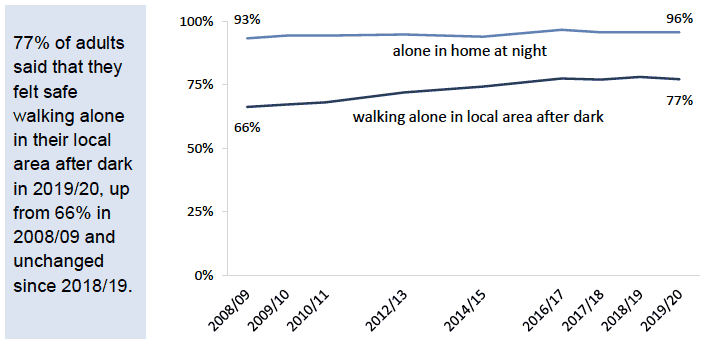
Base: All adults - SCJS 2008/09 (16,000); 2009/10 (16,040); 2010/11 (13,010); 2012/13 (12,050); 2014/15 (11,470); 2016/17 (5,570); 2017/18 (5,480); 2018/19 (5,540); 2019/19 (5,570). Variable: QSFDARK; QSFNIGH.
Despite perceptions improving over the last decade, feelings of safety continued to vary by factors such as gender, age, area deprivation, and rurality in 2019/20.
As shown in Figures 7.4 and 7.5, in 2019/20 the majority of adults in the population sub-groups examined reported feeling safe when walking alone in their local area after dark. There have also been improvements in feelings of safety within most groups since 2008/09, with the exception of victims (where the apparent increase from 61% to 65% is not significant). No apparent changes in the latest year on the charts below are statistically significant.
However, notwithstanding generally positive trends in groups over time, in 2019/20 there continued to be notable differences in relative feelings of safety amongst population groups as depicted. For example, whilst more women and people living in the most deprived areas of Scotland felt safe in 2019/20 than a decade ago, they were still less likely to feel safe than men and people living in the rest of Scotland, respectively.
Furthermore, as improved perceptions have been experienced fairly equally amongst the population since 2008/09, the size of the relative gap in feelings of safety between comparator groups has typically shown little change over the last decade.
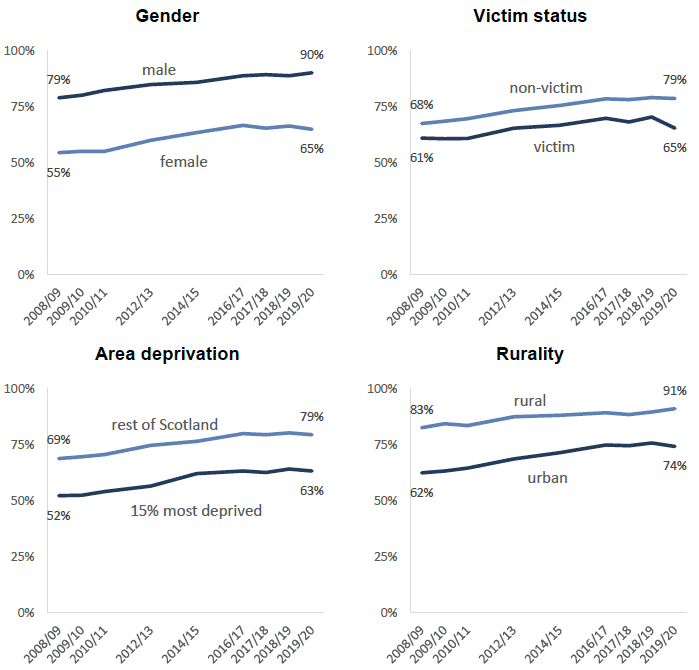
Base: All adults - SCJS 2008/09 (16,000); 2009/10 (16,040); 2010/11 (13,010); 2012/13 (12,050); 2014/15 (11,470); 2016/17 (5,570); 2017/18 (5,480); 2018/19 (5,540); 2019/20 (5,570). Variable: QSFDARK
Turning to results by age, those aged 60 and over remained less likely to report feeling safe than those in other age categories in 2019/20. However, in contrast to the trend seen in other categories, the gap between this cohort and those in younger age groups has almost halved in size since 2008/09, as Figure 7.5 shows. In other words, feelings of safety when walking alone after dark have improved amongst older people at a faster rate than the rest of the population over the last decade.
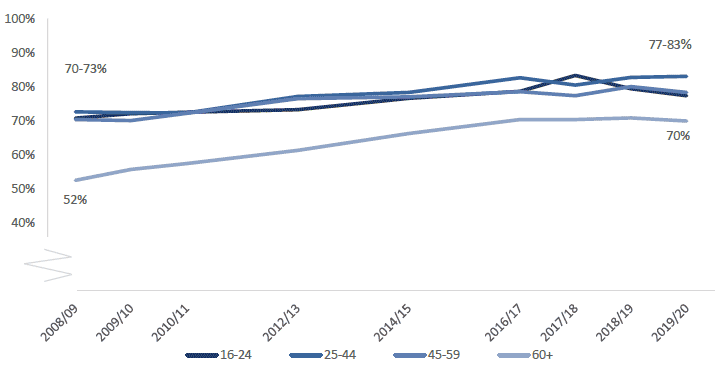
Base: All adults - SCJS 2008/09 (16,000); 2009/10 (16,040); 2010/11 (13,010); 2012/13 (12,050); 2014/15 (11,470); 2016/17 (5,570); 2017/18 (5,480); 2018/19 (5,540); 2019/20 (5,570). Variable: QSFDARK
Looking at perceptions when home alone at night, although generally over nine-in-ten adults across all demographic and geographic categories reported feeling safe, again some differences exist amongst the population. For example, 87% of victims reported feeling safe in their home alone (compared to 97% of non-victims), as did 93% of women (compared to 98% of men). Unlike the measure exploring views when walking alone after dark, no difference was found between most different age groups in relation to feeling safe when home alone, although those aged 60 and over reported feeling safer than those aged 25 to 44 (97% compared to 95%, respectively).
Over the shorter-term, the SCJS detected no change in either measure of perceived safety between 2018/19 and 2019/20 amongst the population groups discussed above. Full results for both questions with breakdowns for key groups, including over time, are provided in Annex tables A1.13 and A1.14.
Using feelings of safety as an analytical variable
Responses to the question about whether adults feel safe walking alone in their local area after dark can also be used to categorise respondents into a group who felt 'safe' and another of those who felt 'unsafe'. These groups can then be used as an analytical breakdown for exploring other measures around perceptions of crime to understand how wider feelings of safety are associated with more specific concerns and opinions. Key findings utilising this breakdown are presented in the sections which follow and this analytical variable is also featured in all SCJS online data tables.
How common were specific crimes believed to be?
Most adults did not think a range of issues were common in their local area in 2019/20, with violence, anti-social behaviour and knife-carrying seen as less prevalent than around a decade ago.
As well as being asked about the local and national crime rates, respondents were asked how common they thought a range of crimes and behaviours were in their area. Table 7.2 shows the issues asked about and the results for 2019/20.
Overall, adults did not consider each issue to be a common occurrence in 2019/20, though some problems were seen as prevalent by a greater proportion of the population than others. Consistent with SCJS findings in recent years, drug dealing and drug abuse was the problem most frequently noted as being very or fairly common, with 45% of adults believing this to be the case in 2019/20. A third of adults (33%) thought people behaving in an anti-social manner was common. In comparison, violence between individuals or gangs and people being physically assaulted were seen as frequent issues by around one-in-ten adults (both 11%).
Table 7.2 also indicates that adults were generally less likely to report problems as common in 2019/20 than when views were first collected on each matter, with perceptions showing stability since the previous SCJS in 2018/19.[90] The most notable outlier in this trend is the perceived prevalence of sexual assault, which has shown an increase since the 2018/19 and 2008/09 SCJS.
Another Scottish Government population survey, the Scottish Household Survey (SHS), also collects information on perceptions of a range of neighbourhood issues including further types of anti-social and nuisance behaviour, alongside a suite of measures exploring wider opinions on the local area. Relevant results are available in the SHS Annual Report and have also found a relationship between increasing area deprivation and an apparent higher prevalence of neighbourhood problems, for example. As questions are asked in a different survey context, any similar measures should not be directly compared to SCJS findings.
| Percentage of adults who thought issue was very or fairly common in their local area | 2019/20 | Change since 2008/09 | Change since 2018/19 |
|---|---|---|---|
| Drug dealing and drug abuse | 45% | No change | No change |
| People behaving in an anti-social manner in public | 33% | ↓ from 46% | No change |
| People having things stolen from their car or other vehicles | 13% | ↓ from 20% | No change |
| People being physically assaulted or attacked in the street or other public places | 11% | ↓ from 19% | No change |
| Violence between groups of individuals or gangs | 11% | ↓ from 26% | No change |
| People having their car or other vehicles stolen | 9% | ↓ from 15% | No change |
| People being mugged or robbed | 6% | ↓ from 10% | No change |
| People being physically attacked because of their skin colour, ethnic origin or religion | 5% | ↓ from 7% | No change |
| People being sexually assaulted | 5% | ↑ from 3% | ↑ from 3% |
| Percentage of adults who thought issue was very or fairly common in their local area | 2019/20 | Change since 2009/10 | Change since 2018/19 |
| People carrying knives | 12% | ↓ from 22% | No change |
| Percentage of adults who thought issue was very or fairly common in their local area | 2019/20 | Change since 2012/13 | Change since 2018/19 |
| Deliberate damage to cars or other vehicles | 18% | ↓ from 25% | No change |
| Deliberate damage to people's homes by vandals | 9% | ↓ from 14% | No change |
| Percentage of adults who thought issue was very or fairly common in their local area | 2019/20 | Change since 2016/17 | Change since 2018/19 |
| People buying or selling smuggled or fake goods | 13% | No change | No change |
Base: All adults - SCJS 2008/09 (4,030); 2009/10 (4,000); 2012/13 (3,020); 2016/17 (1,390); 2017/18 (1,380); 2018/19 (1,400); 2019/20 (1,440). Variable: QACO.
Note: comparisons are made to the year in which questions were first asked.
How concerned were the public about crime?
The SCJS also captures data on how worried the public are about specific types of crime and how likely they think they are to experience them. Whilst the analysis in this section summarises key findings from the questions on these topics, it is important to note that the impact of 'worry' and the perceived likelihood of victimisation will vary from one individual to another. Moreover, even if someone claims they are not worried about a particular crime or do not think they are likely to be a victim, it does not necessarily mean they believe that they are at no risk.
Fraud remained the crime the public were most commonly worried about in 2019/20, although worry about a range of different crime types has fallen in the last decade.
In line with findings in previous years, in 2019/20 the crimes which the public were most likely to say they were very or fairly worried about (from those asked about) were fraud-related issues.[91] More specifically, half (50%) of adults said they were worried about someone using their credit or bank details to obtain money, goods or services, whilst 39% were worried about their identity being stolen. By comparison, under a fifth (16%) of adults were worried about being physically assaulted or attacked in the street or other public place, whilst a tenth (10%) were concerned about being sexually assaulted.
Figure 7.6 (and Annex table A1.25) presents the results on worry about different crimes over time. It highlights that the proportion of adults who were very or fairly worried about experiencing each specific issue was lower in 2019/20 than the 2008/09 baseline. Looking more recently, all measures have been stable or decreased since the last SCJS in 2018/19.
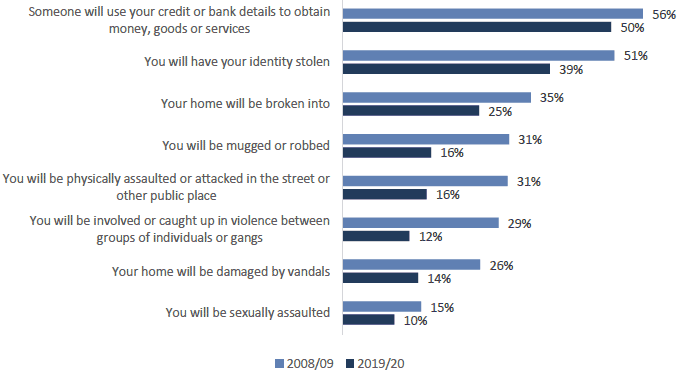
Base: All adults - SCJS 2008/09 (16,000); 2019/20 (5,570); Variables: QWORR_04 - QWORR_11.
In addition to the results shown in Figure 7.6 in relation to all adults, the survey also explores worry about vehicle-related crime amongst adults in households with access to a vehicle. The 2019/20 SCJS found that:
- 29% of adults (in vehicle-owning households) were worried about their car or other vehicle being damaged by vandals
- 20% were worried about things being stolen from their car or other vehicle
- 19% were worried about their car or other vehicle being stolen
A small change to questionnaire routing and the response options[92] for the questions relating to worry about vehicle crime in 2016/17 means that this year now forms the baseline for these questions, with all three measures remaining unchanged or decreased from this point. Prior to this questionnaire update, the three indicators had shown decreasing levels of worry between 2008/09 and 2014/15, as Annex table A1.25 shows.
Whilst the majority of adults did not think they were likely to experience any crime in the year after interview, almost a quarter thought it was likely they would be victims of banking or credit fraud.
Building on the questions exploring worry about crime, SCJS respondents were also asked which of the issues covered, if any, they thought they were likely to experience in the following 12 months. In 2019/20, 57% of adults did not think they were likely to experience any of the crimes covered in the next 12 months, up from 48% in 2008/09 and 50% in 2018/19.
This means that 41% of adults in 2019/20 thought they would experience at least one of the listed crimes in the year following their interview.[93]
Looking at specific issues, the crime type which adults thought they were most likely to experience was someone using their bank or card details to obtain money, goods or services, echoing the pattern seen in the results on worry about crime. Around one-in-four (23%) thought this would happen to them in the next year. This is up from 14% in 2008/09, though has decreased since 2018/19 (26%). Relatedly, 13% of adults thought they would have their identity stolen, unchanged from 2008/09 but down from 15% in 2018/19.
To put perceptions about fraud into context, looking ahead to the year following interview:
- around one-in-eight adults (12%) thought their car or other vehicle would be damaged by vandals[94]
- one-in-twenty (5%) thought they would be physically assaulted in the street or other public place
- one-in-fifty (2%) thought it was likely that they would be sexually assaulted
Annex table A1.26 presents results on expectations around experiencing different crimes over time. It shows that (notwithstanding increased concerns about fraud), the proportion of adults who said it was likely that their car or home would be damaged by vandals, their home would be broken into, they would be mugged or robbed, they would experience violence in a public place, or that they would get caught up in violence from gangs has fallen since 2008/09. That said, there has also been a small but statistically significant increase in the proportion who thought it was likely they would experience sexual assault, from 1% in 2008/09 to 2% in 2019/20.
It is possible to contrast the results on the proportions who thought they would experience each issue in the year following interview with the crime victimisation rates from the 2019/20 SCJS. Whilst these results are not directly comparable (with one being forward and the other being backwards looking), they do offer some insight into the difference between concerns about crime and actual experiences of crime over a broadly similar period. Figure 7.7 shows that generally a much larger proportion of people thought they were likely to experience each crime individually than the proportion of adults or households who were actually victims of such incidents.
For example, 4.7% thought it was likely that they would be attacked in the street in the next year, yet the prevalence rate for all assaults (including those which happened in public places, but also elsewhere) in the 2019/20 survey was 2.4%.
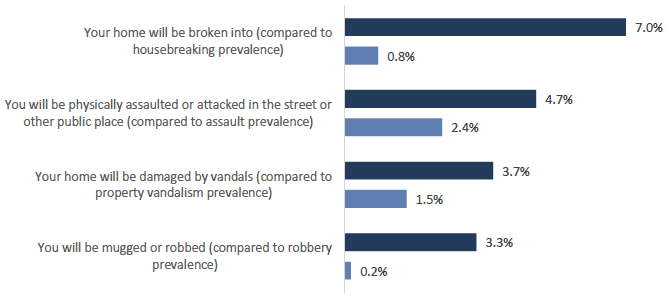
Base: All adults (5,570). Variables: QHAPP; PREVHOUSEBREAK; PREVMOTOVVAND; PREVASSAULT; PREVROB; PREVTHEFTOFMV; PREVTHEFTFROMMV; PREVPROPVAND.
Note: Estimates are shown to one decimal place to facilitate a comparison between prevalence rate for different crime types (proportion of adults/households who were victims) and the perceived likelihood of becoming a victim (usually presented as a rounded figure).
How did perceptions of crime vary amongst the population?
Women, victims of crime and people in deprived areas were among key groups who were relatively more likely to be concerned about crime and perceive issues to be prevalent in their neighbourhood.
This section brings together data on the perceived prevalence of crime, worry about specific crime and respondents' views on how likely they are to experience particular issues in the 12 months following interview to explore whether and how findings differ amongst population groups. In summary, it outlines that, where differences were detected, concerns about crime:
- were generally higher amongst women, victims of crime, people in deprived areas, adults in urban areas and people who felt unsafe when walking alone in their neighbourhood after dark than direct comparator groups
- showed a more complicated picture with regards to differences by age group
Each demographic and area breakdown is explored in more detail below.
Gender
Women had higher levels of concern about crime than men.
Women were more worried than men about experiencing all of the specific crime types which respondents were asked about in 2019/20. This is in line with the finding highlighted previously that females were less likely to feel safe walking alone in their neighbourhood after dark. These results are shown in Figure 7.8.
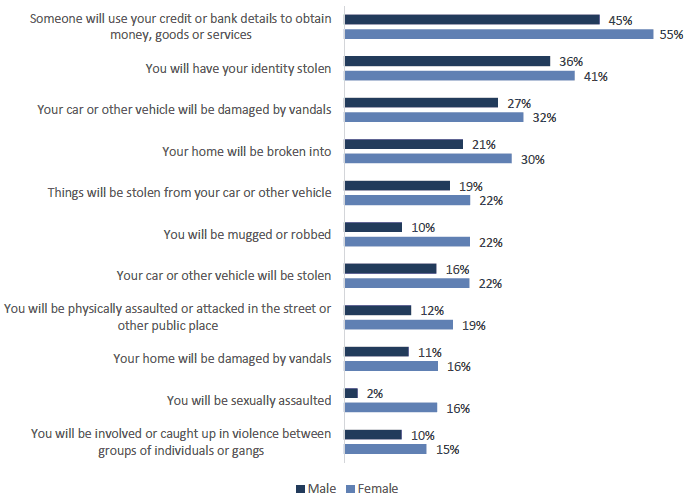
Base: Questions on vehicle theft/damage only asked of those who have access to or own vehicle - male (2,050), female (2,140); all other questions asked of all adults - male (2,570), female (3,000); Variables: QWORR_04 - QWORR_14.
Additionally, a greater proportion of women than men thought it was likely someone would use their bank details to obtain money, goods, or services (25% compared to 21% of men), their home would be broken into (8% compared to 6% of men), their home would be damaged by vandals (4% compared to 3% of men), they would be mugged or robbed (4% compared to 2% of men) and that they would be sexually assaulted (3% compared to less than 1% of men).
Fewer differences were found with respect to the perceived prevalence of different types of crime in the local area. However, women were more likely to consider people having their vehicle stolen and violence between group of individuals or gangs as common issues.
Age
The 2019/20 SCJS found perceptions of crime and safety showed a complex pattern with respect to views by age groups across the range of issues explored.
Although those aged 60 and over were much less likely than other age groups to report feeling safe walking alone in their local area after dark as highlighted earlier, the relationship between age and concerns about specific crime types was more complex.
The 2019/20 SCJS did not find a particularly strong relationship between age and worry about most specific types of crime. That said, there were some differences in particular areas. For example, worry about sexual assault was highest amongst 16 to 24 year olds (17%), as shown in Figure 7.9 below. On the other hand, worry about fraud and identity theft:
- was lowest amongst 16 to 24 year olds
- increased with age to the 45 to 59 age group
- either remained similar or fell again amongst those over 60 (but remained higher than the worry levels of those under the age of 45)
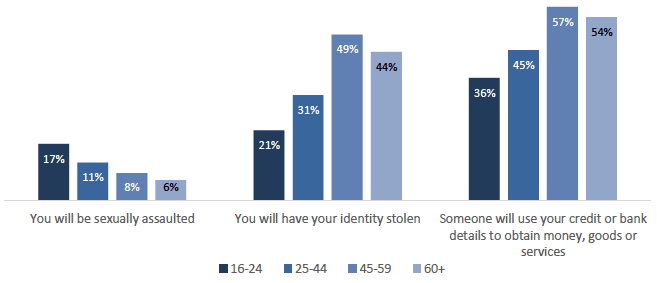
Base: 16-24 (390), 25-44 (1,580), 45-59 (1,420), 60+ (2,190); Variables: QWORR_09 - QWORR_11.
Results also varied with respect to age across some issues when we turn to respondents' perceived likelihood of experiencing crime in the coming year, but not in all cases. For example, those aged 16 to 24 were more likely than those aged 45 to 59 and 60 and over to think they would experience physical assault (in the street or other public place) or that they would be sexually assaulted, but again less likely than these groups to think they would be victims of fraud or identity theft.
On the other hand, no difference was detected across the age groups in relation to the perceived likelihood of being mugged or robbed.
Finally, those aged 60 and over were often the group least likely to view crimes and related issues as common occurrences in their local area, with generally no difference found between those in younger age categories. For example, a smaller proportion of people aged 60 and over thought issues such as violence between individuals or gangs, anti-social behaviour and drug dealing and abuse were prevalent issues in their neighbourhoods, compared to those in other age groups.
Similar to the trends of worry and perceived likelihood, those aged 16 to 24 were more likely than all other age groups to believe that being sexually assault was common in their area (14%, compared to 5% of 25 to 44 year olds, 3% of 45 to 59 year olds and 2% of those aged 60 and over).
Victim status
Recent victims of crime were typically more likely to be worried about experiencing crime again in the future and think they were likely to do so, as well as to view issues as common in their local area.
Across the range of measures, those who had experienced crime in the 12 months prior to interview were generally more likely than non-victims to report worry about crime, think that they were likely to experience types of crime, and that problems were common in their area. The one notable area where there was no difference between victims and non-victims in relation to worry about crime and perceived likelihood of experiencing the crime was identity theft.
Table 7.3 below shows how recent prior victimisation had a strong association with views on the likelihood of experiencing crime in future, with each comparison shown representing a statistically significant difference. For example, whilst 60% of non-victims in 2019/20 said they did not think they would experience any of the listed crimes in the coming year, this was true for only 33% of victims. In other words, the majority of people who had been victims of crime in the previous 12 months, expected to become victims (of some sort of crime) again in the following year.
| Perceived likelihood of experiencing crime type | Victim in 2019/20 SCJS | Non-victim in 2019/20 SCJS |
|---|---|---|
| Someone will use your credit or bank details to obtain money, goods or services | 29% | 23% |
| Your car or other vehicle will be damaged by vandals | 29% | 10% |
| Your home will be broken into | 16% | 6% |
| You will be physically assaulted | 16% | 3% |
| Things will be stolen from your car or other vehicle | 15% | 5% |
| Your car or other vehicle will be stolen | 14% | 4% |
| Your home will be damaged by vandals | 13% | 2% |
| You will be involved or caught up in violence between groups of individuals or gangs | 11% | 2% |
| You will be mugged or robbed | 10% | 2% |
| You will be sexually assaulted | 6% | 1% |
| None of the above | 33% | 60% |
Base: Results on vehicle theft/damage only includes respondents in households with access their own vehicle - victims (450), non-victims (3,740); all other results shown for all adults - victims (600), non-victims (4,970); Variables: QHAPP.
Area deprivation
Reported awareness of and concerns about crime were generally more common amongst adults in the most deprived areas of Scotland.
Where differences were detected, those living in the 15% most deprived areas were typically found to have higher levels of concern about crime than people living elsewhere in Scotland and were more likely to consider issues to be common in their local area.
For example, greater proportions of people in the most deprived areas were worried about experiencing physical violence, being mugged or robbed, and their home being damaged. Those in deprived areas were also more likely to view these matters as common occurrences in their neighbourhood and think they were likely to experience them in the coming year. Figures 7.10 and 7.11 show the results.
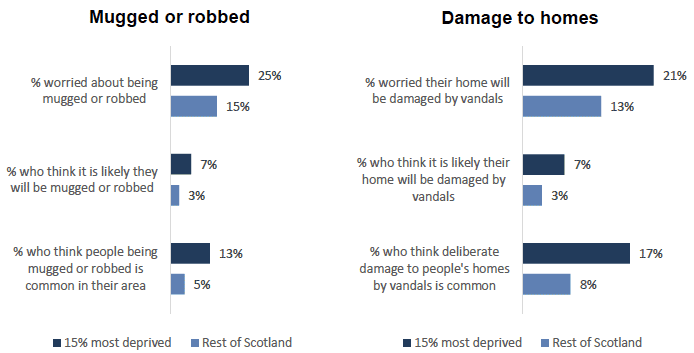
Base: Worry and likelihood - all adults: 15% most deprived (800), Rest of Scotland (4,770); Perceived commonness - all adults: 15% most deprived (200), Rest of Scotland (1,240); Variables: QWORR_04, 06; QHAPP; QACO_05, 14.
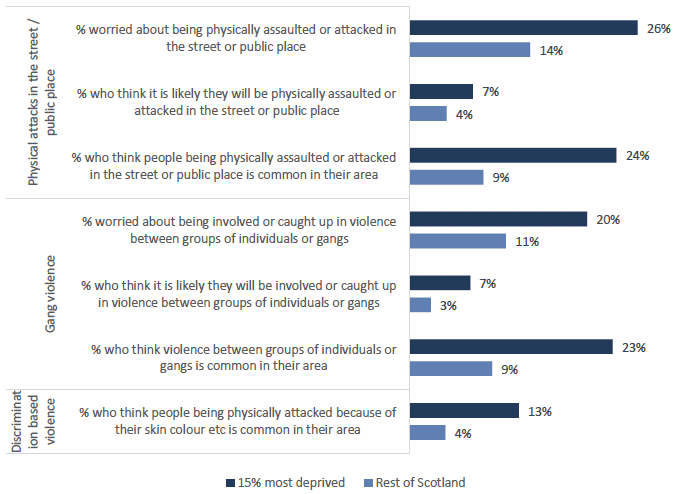
Base: Worry and likelihood - all adults: 15% most deprived (800), Rest of Scotland (4,770); Perceived commonness - all adults: 15% most deprived (200), Rest of Scotland (1,240); Variables: QWORR_07, 08; QHAPP; QACO_06, 07, 11.
However, there were some exceptions to the general trend of greater concern and awareness of crime being associated with increased deprivation. For instance there was no difference in worry, perceived likelihood or commonness in the local area that their/other people's car or other vehicle would be stolen.
Looking at the perceived prevalence of wider issues in the neighbourhood, almost two-thirds of those living in the most deprived areas (63%) considered people behaving in an anti-social manner in public to be a prevalent issue. This was more than double the proportion of people living elsewhere in Scotland who believed this to be a common problem (29%). Likewise, drug dealing and abuse (71% compared to 41%) and knife-carrying (25% compared to 10%) were believed to be more prevalent in local neighbourhoods amongst those living in the 15% most deprived areas.
Rurality
Where differences were found, the perceived prevalence of and worry about specific crimes was higher in urban areas.
Respondents living in urban areas were more worried than those in rural locations about experiencing the range of crimes listed, with the exception of identity theft (which was of more concern to people in rural places) and banking fraud (where no difference was detected). Likewise, greater proportions of people in urban areas tended to think various crimes and problems were common issues in their local area. For instance, issues such as drug dealing and abuse (48% compared to 31%), people behaving in an anti-social manner in public (36% compared to 19%), and people being mugged or robbed (6% compared to 2%) were all seen as more common by people living in urban areas than in rural locations, respectively.
Turning to the perceived likelihood of experiencing crime in the year after interview, a higher proportion of people in rural areas compared to those in urban areas thought they would not be victims of any of the issues covered (62% compared to 56%, respectively). Those in urban areas thought they were more likely to experience some of the particular issues listed, including physical violent crime and their home being broken into or vandalised. For example, in urban areas:
- 5% believed it was likely they would be physically assaulted or attacked in the street or another public place, compared to 3% of rural dwellers
- 3% said they thought they would be involved or caught up in violence between groups of individuals or gangs, compared to 2% of adults in rural locations
Wider perceptions of safety
Feeling unsafe walking in the local area after dark was strongly associated with being more likely to consider specific crimes as regular occurrences in the neighbourhood and increased levels of concern about becoming a victim.
The SCJS found a strong association between more general anxieties about safety (measured by whether people felt safe or unsafe walking alone in their local area after dark, as discussed previously) and concern about specific types of crime.
Those who said they felt unsafe walking alone in their local area after dark were much more likely to worry about experiencing each issue covered by the SCJS than those who felt safe. For example, 41% worried about being mugged or robbed (compared to 10% of those feeling safe), whilst almost four times as many were worried about being physically assaulted or attacked in the street or other public place (37% compared to 10%).
Similarly, people who felt unsafe were typically more likely to view each issue as prevalent in their neighbourhood and were more prone to think they would experience most specific types of crimes in the 12 months after interview. For instance, 14% of those who felt unsafe thought it was likely their home would be broken into during the following year, compared to 5% of those who reported feeling safe. That said, there was no difference in the perceived commonness or likelihood of having things stolen from their car or the perceived likelihood of experiencing identity theft between the 'safe' and 'unsafe' groups, whilst similar proportions also viewed people being physically assaulted because of their skin colour as a prevalent issue in their local area.
It is interesting however to note that despite those aged 60 years old and over being more likely to feel unsafe, they were often less likely to see criminal issues as prominent. The relationship would appear to be more consistent for women, those in deprived areas and victims of crime, as noted above.
How were people affected by their concerns about crime?
Most adults said their concerns about crime did not prevent them from doing things they wanted to do.
Following on from exploring worry about and perceptions of crime, the SCJS gathers information on the impact of such feelings on individual behaviour in order to help put findings in context.
Of those who reported being worried about experiencing some sort of crime, around three-fifths (61%) reported that it did not prevent them from doing things they otherwise wanted to do ('at all'). This is in line with the baseline position when this measure was first collected in 2012/13 (60%) and unchanged from 2018/19 (62%).
In the latest survey, three-in-ten (31%) said they were prevented from doing things 'a little', whilst 6% said it affected them 'quite a lot'. Only 2% said that it affected them doing things 'a great deal'.
Some groups were more likely than others to be affected. For example, women (56%), those in urban locations (58%), victims of crime (45%) and people living in the 15% most deprived areas of Scotland (46%) were all less likely than comparator groups to say that their concerns had not prevented them from doing things they wanted to. Likewise, whilst 72% of those who said they felt safe walking alone in their local area after dark reported that their concerns did not prevent them doing things at all, this figure halved to 35% amongst those who said they felt unsafe.
What steps did people take to reduce their chances of experiencing crime?
The majority of adults took some sort of action in 2019/20 to reduce their risk of being a victim of crime, although take up of different precautions varied.
Respondents were asked which precautions (from a list of potential options) they had taken or had in place in the last year to reduce their risk of becoming a victim of crime, with results shown in Figure 7.12 below.
Almost three-quarters of adults (74%) reported adopting at least one preventative action in 2019/20, with 58% taking two or more actions. Just over a fifth (19%) said they had taken five or more of the listed actions, whilst around a quarter (26%) said they had not taken any of the listed actions.
As in previous years, the most commonly adopted precaution was concealing valuables to make them less visible (reported by 39%).
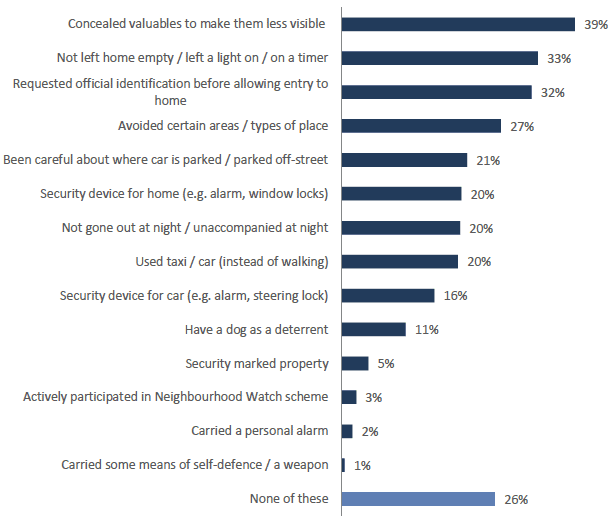
Base: All adults (1,440); Variable: QDONE.
The proportion of adults reporting taking each action has been very stable in the last couple of years, although some actions are more commonly adopted than they were in 2012/13 when figures were first collected. For example, since 2012/13 there have been increases in the proportion of adults reporting:
- concealing valuables (from 27% to 39%)
- not leaving their home empty or leaving a light on (from 26% to 33%)
- asking to see identification before allowing people into their home (from 21% to 32%)
- avoiding certain places (from 23% to 27%)
What did people think about their local community and the collective effort to prevent crime in their neighbourhood?
People generally held positive views about the people in their local area and their contribution to help maintain a safe environment.
Respondents were also asked a series of questions which explored perceptions of neighbourhood cohesion and community support in relation to potential crime and safety issues in the local area.
As shown in Table 7.4 below, most adults gave a positive account of people in their area and their efforts to prevent crime. For example, the majority of respondents indicated they had people nearby they could rely on to keep an eye on their home and that people would call the police if someone was acting suspiciously.
| Percentage of adults | Agree (strongly / slightly) | Neither agree nor disagree | Disagree (slightly / strongly) | Don't know / refused |
|---|---|---|---|---|
| If my home was empty, I could count on one of my neighbours or other people in this area to keep an eye on it | 85% | 4% | 11% | 1% |
| The people who live in my local area can be relied upon to call the police if someone is acting suspiciously | 81% | 8% | 7% | 4% |
| I have neighbours or other people in my local area I feel I could turn to for advice or support | 80% | 8% | 12% | 1% |
| People in this local area pull together to prevent crime | 56% | 22% | 14% | 7% |
| People in my local area cannot be trusted | 14% | 14% | 69% | 3% |
Base: All adults (1,440); Variable: LCPEOP_01 - LCPEOP_05.
Results for different demographic and area breakdowns are provided in the online data tables. They show, for example, that those in deprived areas were less likely to hold positive views than those living elsewhere across all of the indicators.
The Scottish Household Survey report chapter cited earlier, which explores perceptions of neighbourhood problems, also contains a range of information about views on community cohesion and similar matters which may be of interest for wider evidence in this area.
A further SCJS question asked respondents whether they thought broken glass in a park or playground would be removed fairly quickly. In 2019/20, 45% thought this would be the case with 29% disagreeing, and the remainder (26%) giving no clear view or saying don't know. However, whilst respondents are asked to consider how such a problem would be dealt with 'either by local agencies such as the council or residents', the question does not provide information on who respondents feel should be primarily responsible for dealing with this and therefore who they think should be responsible for maintaining or improving the situation described. The proportion agreeing in 2019/20 was in line with the baseline position from 2012/13 and the 2018/19 result.
How would people respond to witnessing crime?
The vast majority of people said they would phone the police and help to identify the perpetrator if they saw someone being robbed.
To explore potential individual level responses to witnessing crime and subsequent actions, survey respondents were asked how they would act in a scenario where they saw a man pushed to the ground and his wallet stolen.
Over nine-in-ten adults said they would be likely to call the police (94%) and willing to identify the person who had done it (90%) were they to witness such an event. A slightly smaller proportion, but still the vast majority, of people would be willing to give evidence against the accused in court (83%). The proportion of adults who said they would be willing to give evidence in court against the accused has decreased since 2012/13 (89%). However the rest of these findings were all unchanged compared to 2012/13, when the questions were first included, and all have shown no change since 2018/19.
Though again most people gave positive responses, those living in the most deprived areas were relatively less likely than those living elsewhere in Scotland to say they would be prepared to identify the perpetrator (81% compared to 92%) or that they would be willing to give evidence in court (74% compared to 84%).
Contact
Email: scjs@gov.scot
There is a problem
Thanks for your feedback